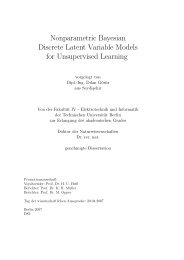FIASCO: Filtering the Internet by Automatic Subtree Classification ...
FIASCO: Filtering the Internet by Automatic Subtree Classification ...
FIASCO: Filtering the Internet by Automatic Subtree Classification ...
You also want an ePaper? Increase the reach of your titles
YUMPU automatically turns print PDFs into web optimized ePapers that Google loves.
statistics on <strong>the</strong> distribution of part-of-speech tags. 4<br />
<strong>FIASCO</strong> 5<br />
The selection of features placed emphasis on being able to classify both nodes with<br />
short texts and nodes containing long text passages correctly. Thus, features such as <strong>the</strong><br />
total length of <strong>the</strong> dominated text or <strong>the</strong> number of sentences immediately below <strong>the</strong><br />
node allow <strong>the</strong> classifier to recognize long text blocks with “average-length” sentences,<br />
which would typically not contain boilerplate. On <strong>the</strong> o<strong>the</strong>r hand, <strong>the</strong> keyword-based<br />
features and <strong>the</strong> proportion of special symbols are intended to distinguish between short<br />
clean and short dirty text blocks.<br />
3.2. Structural features<br />
Structural features mainly provide information about tag or attribute densities in <strong>the</strong><br />
subtree dominated <strong>by</strong> a target node. The intuition behind most of <strong>the</strong> structural features<br />
was that dirty text is likely to contain large numbers of images or external URLs, while<br />
clean nodes are often contained in paragraph, heading, or list elements. Some examples<br />
of structural features are: (i) depth of <strong>the</strong> target node within <strong>the</strong> DOM tree; (ii) whe<strong>the</strong>r<br />
target node is marked as a heading; (iii) whe<strong>the</strong>r target node is a element; and (iv)<br />
<strong>the</strong> proportion of , and tags below <strong>the</strong> target node.<br />
3.3. Visual features<br />
The function of textual components of a Web page cannot always be predicted <strong>by</strong> analyzing<br />
<strong>the</strong> HTML source code. In some cases, function follows form: The visual rendering<br />
of a Web page may reveal formatting subtleties that provide information about <strong>the</strong> purpose<br />
and function of its building blocks. Such information is not accessible to a purely<br />
structure-based or linguistic analysis. Since maps of local features – such as luminance,<br />
color contrast and texture contrast (Schumann 2006) – turned out not to provide much<br />
information about <strong>the</strong> function of text blocks, we decided to focus on <strong>the</strong> geometric<br />
properties of page regions corresponding to text blocks.<br />
In order to recognize page regions corresponding to <strong>the</strong> target nodes identified <strong>by</strong> <strong>the</strong><br />
<strong>FIASCO</strong> system (cf. Sec. 2.2.), we extended <strong>the</strong> Firefox rendering engine with an addon<br />
that changes attributes of specially marked text elements in <strong>the</strong> DOM tree in such a<br />
way that <strong>the</strong>y are displayed as bright purple blocks. Visual features were <strong>the</strong>n extracted<br />
from <strong>the</strong> corresponding regions of a normally rendered version of <strong>the</strong> page, and fed back<br />
into <strong>FIASCO</strong> as a table mapping target nodes to feature vectors.<br />
1998). Sets of keywords were automatically extracted from <strong>the</strong> text version of our gold standard after<br />
tokenization with <strong>the</strong> TreeTagger tokenizer (Schmid 1994). They were ranked <strong>by</strong> keyness, a conservative<br />
estimate for <strong>the</strong> log odds ratio between <strong>the</strong>ir relative frequencies in clean and dirty text, and <strong>the</strong> highestranking<br />
keywords were used in <strong>the</strong> <strong>FIASCO</strong> system.<br />
4 The textual content of <strong>the</strong> subtree below each target node was extracted and tagged with Tree Tagger<br />
(Schmid 1994), using <strong>the</strong> standard English parameter file provided with <strong>the</strong> system. Afterwards, <strong>the</strong><br />
proportions of closed class words, open class words, and unknown words (word forms not listed in <strong>the</strong><br />
tagger lexicon) were computed for each target node. The intuition behind <strong>the</strong>se features is that a higher<br />
proportion of unknown words as well as <strong>the</strong> absence of closed class words are strong indicators that <strong>the</strong><br />
text belongs to a dirty node. Similarly, a high concentration of “special symbols” (words tagged SYM,<br />
various types of punctuation, as well as foreign words tagged FW) within a node is often characteristic of<br />
boilerplate, i.e. dirty text.

















